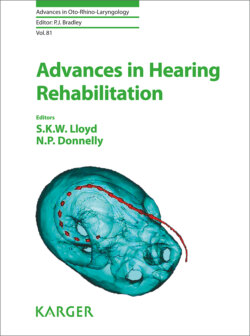Читать книгу Advances in Hearing Rehabilitation - Группа авторов - Страница 36
На сайте Литреса книга снята с продажи.
Efficient Transfer of Force Vectors
ОглавлениеOne of the key areas where prostheses may fail in transmitting vibrations is by attenuating power across the coupling interfaces, primarily the interface from the TM to the prosthesis, and prosthesis and the remaining structures (typically stapes head (stapes head onto malleus [SHOM] or stapes head onto TM [SHOT]; Table 1), or the footplate (footplate onto malleus [FOM] or footplate onto TM [FOT]). There are 2 ways these losses can occur. The first is that there is a gap or compliance such as soft tissue across the interface, which does not transmit certain frequencies well. For instance, large compliances tend to absorb higher frequencies, which are lower amplitude vibrations. In the worst case, a gap will effectively not transmit any vibration energy. Another type of coupling losses at the interface arises if the piston-like in-line force vectors required to drive the stapes footplate efficiently are replaced with rotational movements, because the force vectors have a large rotational moment. Figure 1 show this schematically. The in-line force vector is actually the Cos2 α of the angle in Figure 1, and much of the motion of an angulated prosthesis can be a rotational movement.
By constraining the rotational moment, it is possible to maximize the in-line piston like movement. This is much easier for a reconstruction to the stapes head than to the footplate (i.e., the SHOM and SHOT versus the FOM and FOT reconstructions in Table 1) and is likely one of the reasons that reconstructions utilizing the stapes head perform better than the stapes footplate [12]. Prosthetic designs that use a deep cup that limits the rotational movement will have a mechanical advantage in addition to a stability advantage. The cup should not be so deep that it contacts the promontory, it should not require excessive force to attach, nor result in necrosis of the superstructure and should be easy to revise.
On the footplate, this containment of the rotational movement is much harder to achieve, although people have described various methods to try and stabilize the medial end of the prosthesis including footplate shoes. Whilst they make sense mechanically, they also add damping and additional mechanical impedance, and the shoe can rotate on the footplate. In practice, these shoes can make it difficult to see that the footplate is contacted adequately and may be difficult to place. The ideal prosthesis would bond to the footplate, but this would make revisions difficult. In fact, the truly ideal prosthesis would bypass the footplate, and the impedance of the annular ligament, and transmit energy directly to the vestibular fluids. However, this presents a problem in chronic ear surgery as the ear might be infected or prone to future infections and the TM might medialize and push the prosthesis into the vestibule. In addition, the stapes footplate is mobile and perforating it risks pushing it into the vestibule. These considerations have militated against the use of direct to vestibule prostheses, despite their advantages.
